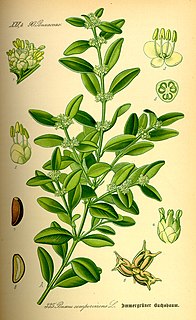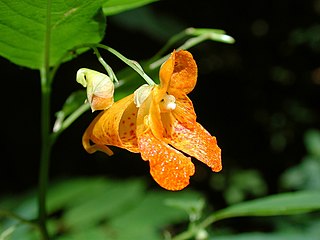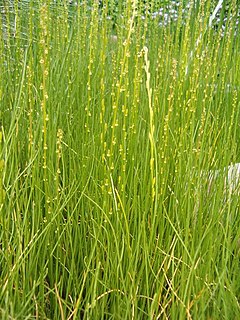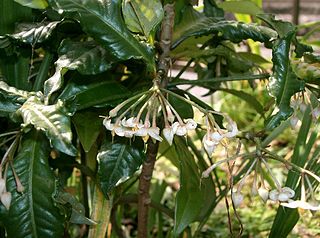
Nymphaeaceae is a family of flowering plants, commonly called water lilies. They live as rhizomatous aquatic herbs in temperate and tropical climates around the world. The family contains five genera with about 70 known species. Water lilies are rooted in soil in bodies of water, with leaves and flowers floating on or emergent from the surface. Leaves are round, with a radial notch in Nymphaea and Nuphar, but fully circular in Victoria and Euryale. It is the national flower of Bangladesh.

The Buxales are a small order of eudicot flowering plants, recognized by the APG IV system of 2016. The order includes the family Buxaceae; the families Didymelaceae and Haptanthaceae may also be recognized or may be included in the Buxaceae. Many members of the order are evergreen shrubs or trees, although some are herbaceous perennials. They have separate "male" (staminate) and "female" (carpellate) flowers, mostly on the same plant. Some species are of economic importance either for the wood they produce or as ornamental plants.

Nyssaceae is a family of flowering trees sometimes included in the dogwood family (Cornaceae). Nyssaceae is composed of 37 known species in the following five genera:

The Oxalidaceae, or wood sorrel family, are a small family of five genera of herbaceous plants, shrubs and small trees, with the great majority of the 570 species in the genus Oxalis. Members of this family typically have divided leaves, the leaflets showing "sleep movements", spreading open in light and closing in darkness.

In the APG IV system (2016) for the classification of flowering plants, the name asterids denotes a clade. Well known plants in this clade include the common daisy, forget-me-nots, nightshades, the common sunflower, petunias, yacon, morning glory, sweet potato, coffee, lavender, lilac, olive, jasmine, honeysuckle, ash tree, teak, snapdragon, sesame, psyllium, garden sage, table herbs such as mint, basil, and rosemary, and rainforest trees such as Brazil nut.

Siparunaceae is a family of flowering plants in the magnoliid order Laurales. It consists of two genera of woody plants, with essential oils: Glossocalyx in West Africa and Siparuna in the neotropics. Glossocalyx is monospecific and Siparuna has about 74 known species.

Juncaginaceae is a family of flowering plants, recognized by most taxonomists for the past few decades. It is also known as the arrowgrass family. It includes 3 genera with a total of 34 known species.

Peridiscaceae is a family of flowering plants in the order Saxifragales. Four genera comprise this family: Medusandra, Soyauxia, Peridiscus, and Whittonia., with a total of 12 known species. It has a disjunct distribution, with Peridiscus occurring in Venezuela and northern Brazil, Whittonia in Guyana, Medusandra in Cameroon, and Soyauxia in tropical West Africa. Whittonia is possibly extinct, being known from only one specimen collected below Kaieteur Falls in Guyana. In 2006, archeologists attempted to rediscover it, however, it proved unsuccessful.

Hanguana is a genus of flowering plants with a dozen known species. It is the only genus in the family Hanguanaceae.

Lanaria is a monotypic genus of flowering plants containing a single species, Lanaria lanata, endemic to the southern coast of South Africa where it is associated with the fynbos belt. Lanaria lanata is commonly known as Cape edelweiss or lambtails. The genus is placed in the monotypic family Lanariaceae, a family only recently recognized by taxonomists. The APG IV system of 2016 does recognize this family.

Olacaceae is a family of flowering plants in the order Santalales with 90 genera and 180 species. They are woody plants, native throughout the tropical regions of the world.

Ardisia is a genus of flowering plants in the family Primulaceae. It was in the former Myrsinaceae family now recognised as the myrsine sub-family Myrsinoideae. They are distributed in the Americas, Asia, Australia, and the Pacific Islands, mainly in the tropics. There are over 700 accepted species. One species, Ardisia japonica is one of the 50 fundamental herbs in traditional Chinese medicine.
Ochanostachys is a genus of flowering plants with a single species, Ochanostachys amentacea. The genus is placed in the family Olacaceae in the APG IV system and by sources that use it. It may alternatively be placed in the family Coulaceae, if the split of Olacaceae into seven separate families is accepted. Ochanostachys amentacea is native to the Andaman Islands, Borneo, Peninsular Malaysia, the Nicobar Islands, Sumatra and Thailand.
Hondurodendron is a monotypic genus of tree endemic to Honduras. The only species in the genus, H. urceolatum, was discovered during 2004 and 2006 botanical surveys of plants in Parque Nacional El Cusuco in northwest Honduras. It was subsequently described in 2010 by Carmen Ulloa Ulloa, Daniel L. Nickrent, Caroline Whitefoord, and Daniel L. Kelly in the Annals of the Missouri Botanical Garden.

The Aptandraceae is a family of flowering plants in the sandalwood order Santalales that is recognized by some sources; others sink the family in Olacaceae. The members of the tropical plant family are parasitic on other plants, usually on the roots, and grow as trees, shrubs or woody lianas.
Aptandra is a genus of flowering plants. In the APG IV system, the genus is placed in the family Olacaceae. Other sources place it in the segregate family Aptandraceae.
Chaunochiton is a genus of flowering plants. In the APG IV system, the genus is placed in the family Olacaceae. Other sources place it in the segregate family Aptandraceae.
Harmandia mekongensis is a species of flowering plants. It is the only species in the monotypic genus Harmandia. In the APG IV system, the genus is placed in the family Olacaceae. Other sources place it in the segregate family Aptandraceae.
Ongokea is a genus of flowering plants, with one species Ongokea gore. In the APG IV system, the genus is placed in the family Olacaceae. Other sources place it in the segregate family Aptandraceae.
Phanerodiscus is a genus of flowering plants. In the APG IV system, the genus is placed in the family Olacaceae. Other sources place it in the segregate family Aptandraceae.













